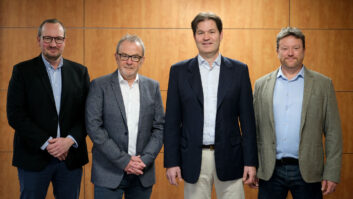Universal City, Calif. — A somewhat soft consumer electronics retail climate in 2007 makes it more important than ever for dealers to sell attachments to their HDTV sales in the year’s closing months, retail panelists said during the DisplaySearch HDTV Forum here Thursday.
Matt Fassler, Goldman Sachs managing director, warned that he has “a somewhat guarded outlook on the holiday season” from a consumer electronics retail perspective.
“Retailers reported a fairly weak September that’s continuing a trend of relatively tepid numbers that we’ve seen all year,” he said. “The downturn in housing-related numbers is contributing to that trend even though the economy is otherwise relatively healthy.”
Despite the growth of HDTV, Fassler said electronics this year have been softer than other product retail categories.
“It certainly has been fairly uneven among the different players,” he observed. “Best Buy has seen a 2 percent same-store sales gain in the U.S. during the second quarter — their August quarter — which wasn’t terrible when you think of the number of product cycles that are converging as we speak. It is certainly not the kind of number that one would have expected if you looked forward to 2007 a couple of years back.”
He said Circuit City was down 8 percent, “which talks to us of the transitional issues and perhaps structural problems that retailer has seen.”
Going forward, Fassler said he expects “continued tepid growth in electronics this year. We are expecting Best Buy — the largest player among the specialty players — to stay at 2 percent same-store sales growth, and we expect Circuit City’s declines to moderate, probably not disappear in entirety, through the end of this year.”
“In the context of this tepid performance one of the bigger disappointments, from where we were a year or two ago, relates to the TV business,” he said. “The flat-panel business for Best Buy … has decelerated every quarter for the past six or seven quarters. We wouldn’t expect that to necessarily abate through the rest of this year.”
Still, Fassler said, Best Buy showed some recovery “in the economics associated with TVs in the second quarter, even as the sales were rather modest. Best Buy showed up TV margins which really shocked Wall Street if you think about the fallout we have seen in this category, particularly over the last holiday season and continuing into the outset of the year.”
Fassler said this indicates “some of the stabilization in the supply chain that most likely will continue over the course of this year, and Best Buy’s improvement in selling the bundle — the bundle through accessories, the bundle through add-ons, the bundle through warranties and the bundle through installations.”
Conversely, he said, Circuit City had a much harder time generating attachments across the board, and consequently that company’s domestic gross margins declined by over 300 basis points.
“That’s roughly 10 times Best Buy’s second quarter domestic gross margin decline,” Fassler said. “The answer here is if you’ve got your act together selling the attachments, selling the bundle as Best Buy seems to, it will be a much bigger contributor from an economic basis in the second half of this year.”
Dave Workman, executive director of the PRO Group, agreed adding that retailers in his association have been familiar with bundling “for quite some time.” He listed some of the key micro trends in bundling as: service and labor, warranties, accessories and audio products.
“As you look at price points moving down there are a couple of areas that are more difficult in the attachment of more profitable items to the sale, specifically the labor component and warranties, especially as you get below $1,000,” Workman said. “As retailers adjust to declining price points you have to rethink the bundle, because some of the traditional mechanisms of just going after the warranty or going after the service and labor may not necessarily apply as you go down stream.”
Workman said that as some of his members have seen a decline in the growth rate of television, they have seen an increase in the growth rate of audio, giving his members a stronger trend line than the industry overall.
Noah Herschman, Amazon.com audio/video director, said his company has long pushed product bundling through online mechanisms that help the purchaser “maximize the experience of the purchase.” This includes personalization reminders that indicate other customers who have purchased an item also purchased a second related item that might be helpful. Amazon also offers a highly trained customer call center to walk customers through complex purchases.
Bob Gartland, president of high-end A/V distributor AVAD, called his A/V installer accounts “specifiers that are much more in control of what a consumer ends up owning than a salesman on a sales floor.”
On the downside these installers tend to make “science projects” out of each installation, which makes their businesses harder to scale up each year.
“One of the things we’ve done is institute AVAD integration partners, and we are working with many of our vendors at the engineering level to actually create more interoperability between the brands so that many of these systems will plug and play and give the feature sets that you would like to see out of the box that typically have to be in a control system with a lot of elaborate programming,” Gartland said.
This requires less highly paid labor to install systems and enables installers to scale their installations upward year upon year.
Workman said margins on installations “aren’t as high as most people think it is,” typically running around 10 percent, “because you are always going to have some waste in your schedule, and you often have to go back to homes because of the lifetime commitment you make to that customer.”
However, “usually the average ticket on equipment is much higher when you attach installations,” he added.
Despite the potential profit benefits, Fassler, of Goldman Sachs, said “it can be challenging for retailers across the spectrum to complement a good in-store experience with a financially successful installation effort. Having a core competency of running a good store and distributing product can be quite different from having a core competency of running a well-oiled service organization.
“The damage you can do to your reputation as a retailer by screwing up… can be significant, particularly if there is damage done inside a consumer’s home,” Fassler warned. “The bar is set quite high for retailers to show that they can do it.”
He called Best Buy’s Geek Squad and Circuit City’s firedog “good efforts” that have required hard work and a lot of resources to develop properly.
Yet, “the jury’s still out,” on the long-term success of the programs, Fassler said.
For this reason, Workman said he believes the trend over time will be for larger retailers to outsource service and support programs.
Asked what the next big product will be for CE retailing after 1080p HDTV, Workman said “I don’t know that there is going to be a defining next big thing. Too many times I think the industry looks for a home run … what I do believe is going to be the case is we are going to see a lot of base hits, whether that is high-contrast ratio, Internet-provided TV, LED backlight … We will see a series of base hits combined to make a winning score.”
Herschman said “we see a lot of different technology on our best-seller lists, and one that we see a lot is DLP technology, which still has strong demand. There is going to be a lot of interesting things coming from them, including laser and 3D, which will be good for gamers. Also, HD DVD and Blu-ray consistently rank at the top of our lists. The HD-A2 from Toshiba is the No. 1 selling DVD player in units today.”











